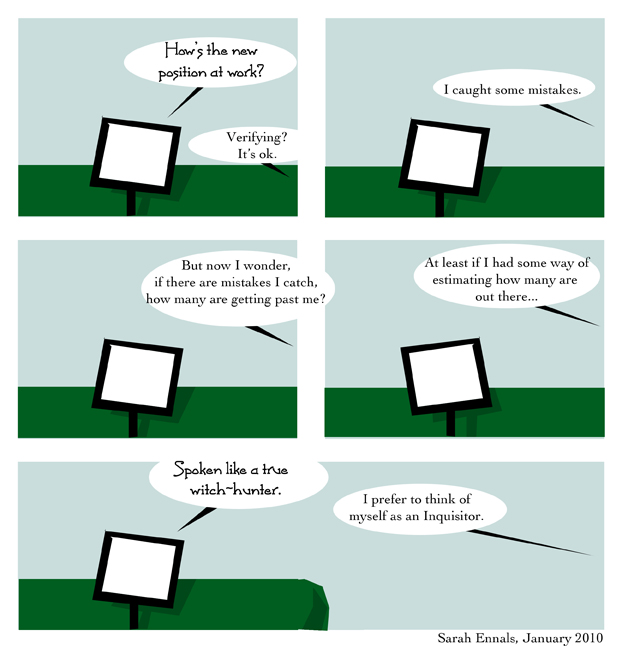 It seems like ages since I last relinked any good writing advice here, so let’s take a look at a few items that got tangled up in my intertube trawler-nets this week. First of all Luke Reid points us toward the blog of the pseudonymous Doctor Grasshopper, a medical student and sf/f author who aims to provide useful tips for other writers who want to include realistic diseases and injuries in their plots:
It seems like ages since I last relinked any good writing advice here, so let’s take a look at a few items that got tangled up in my intertube trawler-nets this week. First of all Luke Reid points us toward the blog of the pseudonymous Doctor Grasshopper, a medical student and sf/f author who aims to provide useful tips for other writers who want to include realistic diseases and injuries in their plots:
… what I’d really like to do is provide a bit of groundwork for starting from a desired symptom and working your way to figuring out how to make it happen in a marginally medically plausible way. Some posts will be symptom-based, and will discuss different ways to produce the symptom. Some posts will be about broad categories of diseases, and how they work. Some posts will be organ-system-based, and will basically be me geeking out about how cool the human body is. And of course, I reserve the right to post miscellany as I see fit.
She’s inviting specific questions from the audience, too, so go subscribe to the RSS feed; expertise is an invaluable resource, after all, and free is the best price.
Jeff VanderMeer’s Booklife blog (an online supplement to the book of the same title) is spooling out a bunch of interesting guest posts at the moment, including this little gem from Jeremy L C Jones; if you’ve heard the writerly aphorism “show, don’t tell” but never quite understood what it means, this post should shed some light on the subject.
… I am often surprised at how many of my students haven’t heard “Show, Don’t Tell” or who have heard it but don’t get it. There comes a time in each semester when I have to explain the difference between showing and telling.
Usually, this can be taken care of with a simple demonstration.
“I am happy,” I say. ”That is telling.”
Then I jump up and down, hooting and pumping my fists in the air. “And that is showing.”
They all smile and nod. They get it! I am a proud teacher.
Click through for examples and exercises; excessive exposition and blunt telling are the most frequent problems I encounter in manuscripts sent to me for critique, and slush readers of my acquaintance bump into it a great deal, too. Jones’ post should help you grasp the root of the problem, and show you some routes to solving it.
Shifting gear to a somewhat more meta level, John Ginsberg-Stevens pops in to the Apex Book Company blog to look at one of the less-discussed cogs in the genre writer’s gearbox: the annihilation of history.
… I think this is a vital engine in the creative mechanism of SF. Whether there’s been a zombiepocalypse, an alien invasion, or a high adventure 10,000 years in the future, the genre thrives on messing with history, taking it apart, or brazenly dismissing it to focus on something else. This applies to genre history as much as it does to actual history, as later generations absorb or break the past to fuel their own creations. From Heinlein’s classic Future History to recent works like Paolo Bacigalupi’s The Windup Girl and Caitlín R. Kiernan’s The Red Tree, history is subjected to an act of destruction that may alter it into something new or unrecognizable, recombine it, or entirely eliminate it. This could be an Asimovian reformulation of the grand sweep of history, or the intimate breakdown and evocation of local history and folklore into something very different.
This act of destruction can produce a lot of creative energy, and can also focus the audience’s attention on what is important in a narrative.
Some good ideas for critics, reviewers and regular readers in there, too.
Last but not least, it’s back to Luc Reid for one of his own posts, which discusses how to turn a neat idea into a viable story – one of the bits I always struggle with! Reid identifies four basic approaches:
A) Create a beginning situation and let the story take its own course
B) Build an outline
C) Develop an excellent scene
D) Write a first sentence as a jumping-off point
Here’s a snippet from the first approach:
Once you have a character who wants something different from what’s going on, the story has a chance to take off. Whatever you do, don’t give the character what she or he wants–at least not right away. Preferably, make that thing more important and more difficult the deeper we get into the story. If you’re writing off the cuff, it pays to throw every new problem you can think of at your character and let your character try to find their own way out. Of course, they have to continue to have a desire or need they’re following to plot their course, at least in most cases.
Good stuff, clearly explained… Reid’s a good writer to follow if you want useful advice on developing your fictional chops. [image by Marco Arment]
Have you got any recommendations for good writerly advice online? Or a tip or hack of your own to share?

 Ars Technica has an interesting article about
Ars Technica has an interesting article about  It seems like ages since I last relinked any good writing advice here, so let’s take a look at a few items that got tangled up in my intertube trawler-nets this week. First of all
It seems like ages since I last relinked any good writing advice here, so let’s take a look at a few items that got tangled up in my intertube trawler-nets this week. First of all  Futurismic readers resident outside the UK may wonder why exactly it is that I keep battering on about the omnipresent surveillance systems that are saturating this silly little island. After all, if I’m not doing anything wrong, I should have nothing to fear, right?
Futurismic readers resident outside the UK may wonder why exactly it is that I keep battering on about the omnipresent surveillance systems that are saturating this silly little island. After all, if I’m not doing anything wrong, I should have nothing to fear, right? Consider, for a moment, the trials and tribulations of the plastic artist. You create your masterpiece, and – if you’re lucky – you sell it. And that’s your lot – not only is it beyond your control once it leaves your studio, but it can’t make you any further income.
Consider, for a moment, the trials and tribulations of the plastic artist. You create your masterpiece, and – if you’re lucky – you sell it. And that’s your lot – not only is it beyond your control once it leaves your studio, but it can’t make you any further income.